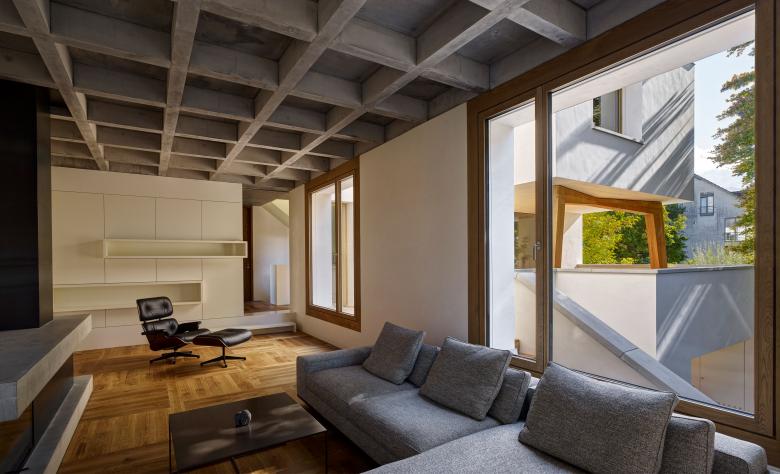Spatial Sculpture with Living Quality
Vaduz, Liechtenstein
A response to the local surroundings, the incorporation of a mature beech tree and a balance between privacy and openness, all combining to make a strong case for sustainable building: such was the brief for a new detached family home in Vaduz, Liechtenstein. Baumschlager Eberle Architekten succeeded in meeting all the client’s wishes sustainably with a genuinely custom-built house.
“The desire for sheltered exterior spaces was a key factor in the conception of this very sculptural structure. It allowed us to create a number of very different private spaces,” explains Ulli Grassmann, managing partner at Baumschlager Eberle Architekten.
Positioned on the plot with pinpoint accuracy, the design follows its topography with a three-storey structure and a gross floor area of 346m², offering a nuanced counterpoint of privacy and exterior views. The site lends itself naturally to the L-shaped layout which, together with the beech tree, forms a sort of interior courtyard. With its carefully planned recesses and cut-ins, the building has a strongly sculptural form. Selected materials, high-quality craftsmanship and a high-efficiency energy concept add to the house’s environmental credentials.
The project
The building is more than just a structure placed on a garden site. It relates to its surroundings in various ways, including through its relationship with the mature beech tree that forms a central element of the design. The house also has a clear street side with a covered entrance and two sheltered terraces.
In the words of Ulli Grassmann, “The sculptural form of the building is the result of the interplay between the structure itself and its openings and outdoor spaces. The top floor on the street side, for example, appears to float above the first-storey terrace, discreetly supported by a trapezoidal wooden beam. The ground floor features a sheltered entry area, while the visually asymmetrical yet functionally logical arrangement of the windows breaks with the conventions of classic villa architecture.”
Leaving aside its form, the house is characterised primarily by the use of three materials – oak, untreated concrete and a series of light-coloured renders – together with a spatial and material quality that is underscored by high quality craftsmanship. Outside, the combination of rendered block walls and oak window frames reinforces the abstract, sculptural quality of the architecture.
The monolithic masonry, natural/untreated building materials, lime render and minimal use of insulating materials add to the house’s environmental credentials. The durability and so the sustainability of these materials stand at the very heart of a design process in which the thickness of the concrete slabs was minimised to save resources and simple clay insulating blocks reduce energy losses to a minimum. Together with the concrete slabs, these blocks create a high thermal mass that stores solar energy gains and guarantees pleasant indoor temperatures even in the summer.
With its environmental and aesthetic quality standards, the building, which was completed in 2020, bridges the gap between traditional building techniques and contemporary innovative architecture, in every respect a subtle reinterpretation of classic villa architecture.












